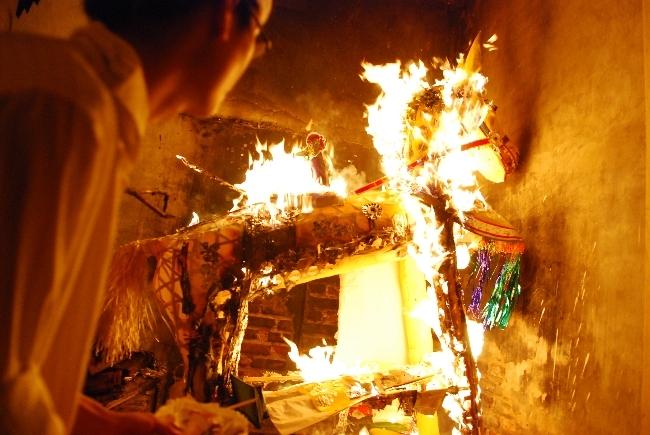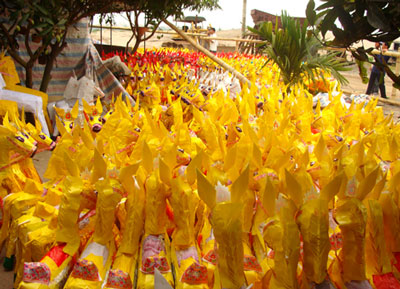Hanoi’s people spend more than VND400 billion ($20 million) per annum in burning paper-made products for the dead, statistics reveal.
 |
In the month for ghost (the 7th month of lunar calendar), Buddhist temples in Vietnam are very crowded. Families prepare paper-made products to burn for the dead. Tonnes of paper-made products are burnt each day, worth tens of thousands of USD.
According to a recent survey, around 50,000 tonnes of paper-made products are burnt in Vietnam annually. Hanoi alone spends more than VND400 billion or $20 million for this. At Ba Chua Kho temple in Bac Ninh Province, paper-made products worth VND80-100 million ($4,000-5,000) are burnt each day.
“Honours change manners.” Nowadays, in the Vu Lan Buddhist Festival, Vietnamese people not only burn votive papers, but also paper-made products that feature the modern life for the dead; such as villas, cars, fridges, washing machines and even passports and credit cards.
“Some customers pay tens of million dong of real money to purchase paper-made products to send to the after world during the Vu Lan festival,” says Nguyen Van Binh, who runs a votive paper shop near Hanoi’s Dong Xuan Market.
Thanh, who operates a votive paper shop in Kham Thien Street, Hanoi, told Lao Dong newspaper: “A set of normal clothes, jewelry, and personal items is priced several thousands VND. If you want brand products, the price is several million VND. If you need special items, you have to order in advance. Around half of a month ago, my customers booked villas, aircrafts, cars worth thousands of USD.”
Mai, director of a private company in Hanoi, told Hanoimoi Newspaper: “The life in the afterworld is similar to our world. Dead people still have demands like the living. I assign an elderly staff to burn incense and votive papers every fifteen day of lunar months. We spend around VND100,000 ($5) for votive papers each month. In special days like the fifteen day of the first or seven lunar months or the day of the Kitchen God, we burn millions VND of votive papers. Once in 2009, wepaid over VND30 million dong for votive paper. That has been the largest offerings for the dead at my company so far.”

Mai thinks that the more votive papers she burns, the more money the dead receive and they will support her business.
At other companies, the situation is the same.
During the Vu Lan Buddhist Festival 2009, a sand mining firm “made a record” in burning 1,000 paper-made horses and dummies, boats, gold bars, etc. worth more than $20,000 for the Kitchen God and the God of Hanoi’s Red River to wish for the increase of sand price.
Some pagodas in Ho Chi Minh City have called for Buddhist followers to stop burning votive papers and donate to charity funds. From 1998 to 2010, Lien Hoa Pagoda in Ho Chi Minh City raised over VND6 billion ($300,000) from this source.
Many senior Buddhist monks advice followers to give up burning votive papers. “Some people maltreated their parents when they were alive and burnt a lot of votive papers for their parents after they died. It is nonsense!” says venerable monk Thich Thanh Tu from Hanoi’s Quan Su Pagoda.
Buddhist monks advice followers to spend money in charity activities rather than burning votive papers.
In 2010 the government issued a decree which says those who burn votive papers at festivals, cultural and historical relics or public sites will be fined from VND500,000 to VND1 million ($25-50).

Leave your comment on this story